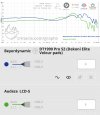TheFrator
Member
What is the relationship between these two terms? There seems to be a common sentiment that the more treble a transducer has, the more "resolving" it sounds. But this isn't always the case with my subjective, sighted listening impressions of various headphones and speakers. I've heard various dark transducers (confirmed by headphone measurements online and UMIK-1 with REW for speakers) that sound more "resolving," especially with acoustic music.
My definition for "resolving" I am using is from from this site (Headphonesty) and states: "The equipment’s ability to reproduce and separate the sounds between individual instruments. Detail is the interpretation of the reproduced resolution." Also related to this definition is "detailed." Same source defines it as: "A strong midrange and treble, as well as fast transient response, that conveys the most subtle elements in the music."
Forgive me if this belongs in the Psychoacoustics section of the forum. Thank you for reading and commenting. I'm simply trying to learn and make sense of my auditory experiences.
My definition for "resolving" I am using is from from this site (Headphonesty) and states: "The equipment’s ability to reproduce and separate the sounds between individual instruments. Detail is the interpretation of the reproduced resolution." Also related to this definition is "detailed." Same source defines it as: "A strong midrange and treble, as well as fast transient response, that conveys the most subtle elements in the music."
Forgive me if this belongs in the Psychoacoustics section of the forum. Thank you for reading and commenting. I'm simply trying to learn and make sense of my auditory experiences.

